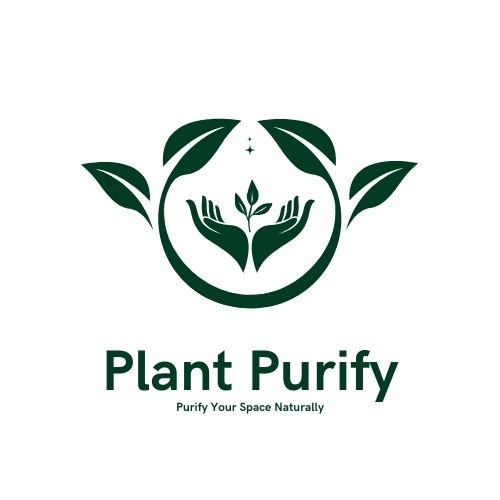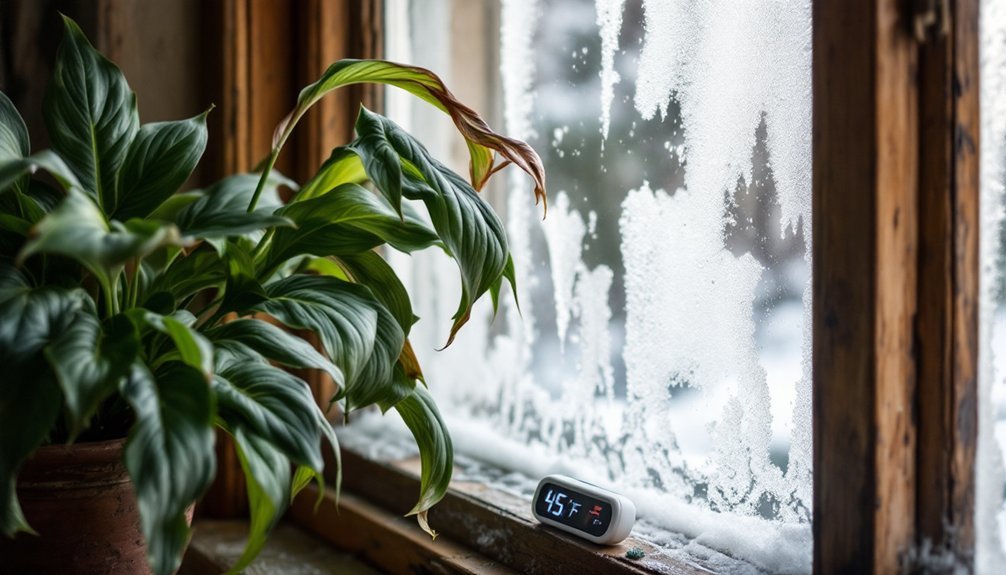Combat dangerous paint fumes in your home with these powerful air-purifying plants: The Areca Palm excels at removing paint thinners, while Peace Lilies filter multiple VOCs and add moisture to the air. Spider Plants tackle formaldehyde effectively, and Chrysanthemums neutralize paint solvents and varnishes. For shadier areas, try the hardy Spathiphyllum to target fresh paint emissions. Proper placement and care of these natural air filters can transform your indoor air quality greatly.
Why Paint Fumes Are Harmful to Your Health

While a fresh coat of paint can transform any space, the fumes it releases pose serious health risks that shouldn't be ignored.
You'll likely experience immediate symptoms like headaches, dizziness, and eye irritation when exposed to paint fumes. Your throat and lungs may become irritated, making breathing difficult, and you might feel nauseous. Paint can continue to emit harmful chemicals for up to several years, even after the surface appears completely dry.
What's more concerning are the long-term risks. Paint fumes contain dangerous chemicals like VOCs, formaldehyde, and dichloromethane that can damage your nervous system, liver, and kidneys over time.
You're especially vulnerable if you have respiratory issues, pre-existing medical conditions, or if you're very young or elderly. These toxic compounds can lead to chronic respiratory problems, irregular heart rhythms, and even increase your risk of certain cancers through prolonged exposure.
The Science Behind Plants and VOC Removal
Three main pathways allow plants to naturally filter VOCs from the air you breathe.
First, the leaves absorb toxins through tiny pores called stomata and their surface area.
Second, beneficial microorganisms in the soil break down 50-65% of the VOCs.
Third, roots work with the growing medium to pull chemicals down through transpiration.
You'll find that different plants excel at removing specific VOCs.
For example, some might be better at filtering benzene while others tackle formaldehyde more effectively.
The removal process depends on several factors, including light intensity, temperature, and the type of growing medium you're using.
Even the concentration of VOCs matters – plants can handle higher amounts up to a certain threshold.
In indoor settings with paint fumes, you'll want to take into account these factors when choosing your air-purifying plants.
Prolonged exposure to high VOC levels can cause liver and kidney damage, so it's essential to implement effective plant-based filtration systems.
Top Plant Picks for Eliminating Paint Emissions

The most effective plants for combating paint fumes combine high VOC absorption rates with easy maintenance.
You'll want to focus on species that specifically target common paint-related chemicals like xylene, toluene, and formaldehyde. Using non-toxic paint options can significantly reduce harmful emissions in your space before adding plants.
- Areca Palm stands out as your best choice for removing paint thinners and nail polish remover chemicals, thriving in humid environments with minimal sunlight.
- Peace Lily excels at filtering multiple VOCs while adding moisture to your air through its high transpiration rate.
- Spathiphyllum specifically targets fresh paint emissions and acetone, making it ideal for newly painted spaces.
- Chrysanthemum effectively filters both varnishes and paint solvents while adding a decorative touch to your room.
These plants don't just purify your air – they'll also enhance your space with their natural beauty while requiring relatively simple care.
Optimal Plant Placement and Care Tips
Proper placement and care of your air-purifying plants will maximize their effectiveness against paint fumes. Position plants in areas with appropriate lighting – semi-sunlight for rubber plants and Dracaena, bright indirect light for Boston ferns.
Maintain temperatures between 60-80°F and guarantee good air circulation for ideal toxin removal.
To keep your plants healthy, check soil moisture by inserting your finger to the second knuckle before watering. Mist humidity-loving plants like Areca palms regularly with distilled water.
Watch for signs of distress, including brown leaf tips or unusual spotting. Resist moving plants once they're established, as this can shock them.
Regular pruning of dead leaves and appropriate fertilization with nitrogen-rich products for foliage plants will keep them thriving and actively filtering paint fumes.
Creating Your Indoor Clean Air Garden

With your plant care knowledge in place, building an effective indoor clean air garden takes strategic plant selection and thoughtful arrangement.
Combine fast-growing plants like Pothos with powerful VOC removers like the Areca Palm to create a thorough air-purifying system. Layer your garden with varying heights and growth patterns for maximum effectiveness and visual appeal.
- Start with an Areca Palm as your centerpiece for tackling tough paint fumes like xylene and toluene.
- Add Spider Plants in hanging baskets to maximize vertical space and remove formaldehyde.
- Place Peace Lilies in shadier corners to combat benzene while adding humidity.
- Include English Ivy along windowsills to reduce airborne mold and absorb formaldehyde.
Mix and match these air-purifying champions based on your space's lighting conditions and maintenance preferences.
Frequently Asked Questions
How Long Does It Take for Plants to Start Removing Paint Fumes?
While your plants will start absorbing VOCs immediately, you'll notice improvements in air quality over several days. It's best to combine plants with ventilation for faster results in removing paint fumes.
Can These Plants Become Toxic After Absorbing Too Many VOCS?
You don't need to worry about plants becoming toxic from VOCs. They won't harm you as long as VOC levels stay within safety limits. Even after absorption, plants safely metabolize these compounds without becoming hazardous.
Should Plants Be Replaced After Exposure to Heavy Paint Fumes?
You don't need to replace plants after heavy paint fume exposure. They naturally metabolize and neutralize toxins rather than store them. With proper care, your plants will continue to effectively filter the air indefinitely.
Do Artificial Plants Help Filter Any Paint Fumes From the Air?
No, artificial plants won't help filter paint fumes from your air. While some artificial plants can convert CO2 to oxygen using bacteria, they aren't designed to remove VOCs or other harmful paint chemicals.
Which Plants Work Fastest to Remove New Paint Smell Specifically?
You'll get the fastest results with English Ivy, which removes 97% of paint-related toxins in eight hours. Peace Lily and Dracaena also work quickly to eliminate paint fumes through rapid toxin absorption.
In Summary
You're now equipped to create your own natural air-purifying system using these powerful plants. Remember to position your plants strategically throughout freshly painted rooms and maintain them properly for maximum VOC removal. By incorporating these green warriors into your home, you'll breathe easier knowing they're working around the clock to combat harmful paint fumes. Start small with one or two plants and expand your indoor clean air garden gradually.
References
- https://foobot.io/guides/plants-that-remove-volatile-organic-compounds.php
- https://sanuvox.com/en/blog/do-air-purifiers-work-for-paint-fumes/
- https://manuu.edu.in/dde/sites/default/files/DDE/DDE-SelfLearnmaterial/BA-6thSemester/Englishba6th28may24.pdf
- https://www.freshwaveworks.com/blogs/tips-how-to-use/5-popular-plants-that-clean-air-indoors-and-improve-air-quality
- https://www.scmp.com/yp/discover/lifestyle/features/article/3067821/discover-innovate-smell-fresh-paint-more-dangerous
- https://molekule.com/en-ca/blogs/all/are-paint-fumes-bad-to-inhale-in-your-home
- https://www.trusens.com/news/blog/paint-fumes/
- https://int-enviroguard.com/blog/paint-fumes-the-hidden-dangers-that-cause-adverse-health-conditions/
- https://www.airmatic.co.uk/knowledge-hub/inhaling-paint-dangerous/
- https://greenplantsforgreenbuildings.org/wp-content/uploads/2014/09/Dela-Cruz-2014-review-on-phytoremediation-with-indoor-plants-2.pdf





Leave a Reply